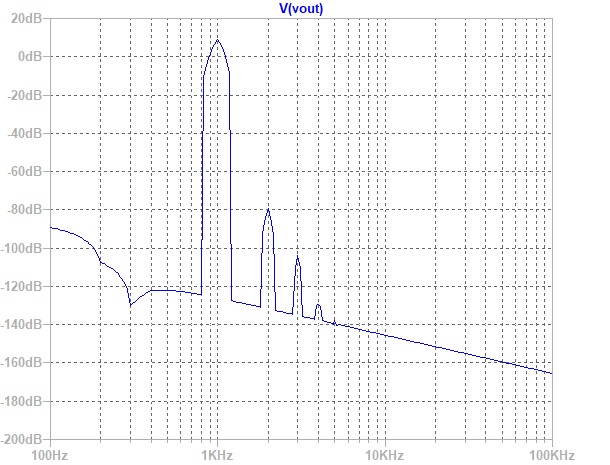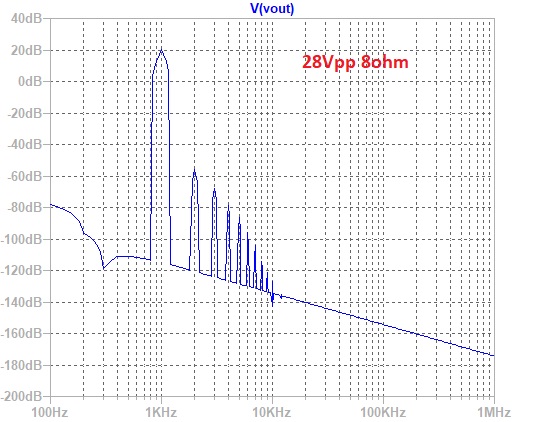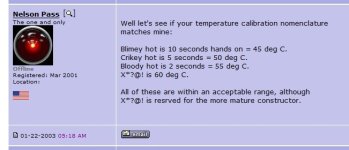Ah, those molex connectors...... Andy hated them too.
Sorry to hear about this Scott. It slows you down quite a bit.
Hugh
Sorry to hear about this Scott. It slows you down quite a bit.
Hugh
Anand,
Hugh,
Main Alpha board.
No big deal the other one will go together fast once board and parts get here.
Scott
Hugh,
Main Alpha board.
No big deal the other one will go together fast once board and parts get here.
Scott
I am pretty sure you can just solder the wires to the adequate parts, no need for connector. Even if you ripped some part of trace, you can easily find out where it leads and use other spot.
Here is the Alpha Nirvana v2 schematic with Hugh's latest tweaks:

Here is the behavior at clipping - notice how symmetric it is:

Here is the FFT for 8Vpp into 8ohms:

Here are the distortion components with 0.0039% THD:
Code:Harmonic Frequency Fourier Normalized Phase Normalized Number [Hz] Component Component [degree] Phase [deg] 1 1.000e+03 3.937e+00 1.000e+00 -0.68° 0.00° 2 2.000e+03 1.538e-04 3.906e-05 -113.08° -112.40° 3 3.000e+03 8.049e-06 2.045e-06 56.41° 57.09° 4 4.000e+03 1.027e-06 2.608e-07 164.55° 165.23° 5 5.000e+03 1.262e-06 3.207e-07 -177.53° -176.85° 6 6.000e+03 1.038e-06 2.637e-07 179.93° 180.61° 7 7.000e+03 8.854e-07 2.249e-07 179.88° 180.56° 8 8.000e+03 7.748e-07 1.968e-07 179.92° 180.60° 9 9.000e+03 6.887e-07 1.749e-07 179.93° 180.61° 10 1.000e+04 6.198e-07 1.574e-07 179.94° 180.62° 11 1.100e+04 5.635e-07 1.431e-07 179.94° 180.63° 12 1.200e+04 5.165e-07 1.312e-07 179.95° 180.63° 13 1.300e+04 4.768e-07 1.211e-07 179.95° 180.63° 14 1.400e+04 4.427e-07 1.125e-07 179.95° 180.64° 15 1.500e+04 4.132e-07 1.050e-07 179.96° 180.64° Total Harmonic Distortion: 0.003912%(0.004251%)
And here is FFT for 28Vpp into 8ohms (12.5w):

And here are the distortion components for 0.016% THD:
Code:Harmonic Frequency Fourier Normalized Phase Normalized Number [Hz] Component Component [degree] Phase [deg] 1 1.000e+03 1.417e+01 1.000e+00 -0.68° 0.00° 2 2.000e+03 2.278e-03 1.608e-04 -115.76° -115.08° 3 3.000e+03 5.799e-04 4.092e-05 51.25° 51.93° 4 4.000e+03 1.615e-04 1.139e-05 20.66° 21.34° 5 5.000e+03 6.764e-05 4.773e-06 -110.87° -110.19° 6 6.000e+03 2.623e-05 1.851e-06 -177.51° -176.82° 7 7.000e+03 8.719e-06 6.152e-07 98.94° 99.62° 8 8.000e+03 3.366e-07 2.375e-08 -37.39° -36.70° 9 9.000e+03 2.908e-06 2.052e-07 -157.53° -156.85° 10 1.000e+04 2.602e-06 1.836e-07 178.74° 179.43° 11 1.100e+04 1.990e-06 1.404e-07 176.05° 176.73° 12 1.200e+04 1.803e-06 1.272e-07 -179.77° -179.08° 13 1.300e+04 1.709e-06 1.206e-07 -179.55° -178.87° 14 1.400e+04 1.588e-06 1.121e-07 179.91° 180.60° 15 1.500e+04 1.477e-06 1.042e-07 179.90° 180.58° Total Harmonic Distortion: 0.016635%(0.016717%)
Looks like fun!
Question - what about using JFETs for LTP?
Also - is there a way to get more power? Say 100W?
Maybe you could run a pair in balanced configuration for 80 watts, but would be kind of a waste. I ran a pair of F4 stereo amps that way, great way to heat a room but you just don’t listen to 80 watts continuously. The extra watts are good for headroom and a class d or ab is far more practical.
Bill
Bill
Besides the points that wirewiggler brought up, also bear in mind that doing a balanced bridged configuration will cancel 2nd harmonic distortion, and this amplifier design was specifically tuned for a certain harmonic structure profile (see 1st page of this thread); at which point, it’s not an Alpha Nirvana anymore. Hugh Dean has written about his philosophy with regards to the harmonic profile.
Best,
Anand.
Best,
Anand.
Anand,
Funny you mentioned that, I have been enjoyed my F4 running single ended with a ASKA Lender preamp driving it. Mr Pass had mentioned current buffers amps sounding better on full range speakers. The combo driving my little Fugal Horns in my office sound glorious.
Bill
Funny you mentioned that, I have been enjoyed my F4 running single ended with a ASKA Lender preamp driving it. Mr Pass had mentioned current buffers amps sounding better on full range speakers. The combo driving my little Fugal Horns in my office sound glorious.
Bill
Gee, those Modushop 5RU, 350mm deep cases (single heatsink each side) that I bought for my AN 4Rs, certainly work well as total heatsinks! 🙂
Winter has arrived so I have put my ANs back in the system ... after most of the day turned on, panel temps (outside) are as follows:
* heatsinks (not the fins thereof) in the middle of the bolts holding the output devices - 72 deg C
* front panel, centre - 48 deg
* back panel, centre - 47 deg
* top panel, centre - 47 deg.
Winter has arrived so I have put my ANs back in the system ... after most of the day turned on, panel temps (outside) are as follows:
* heatsinks (not the fins thereof) in the middle of the bolts holding the output devices - 72 deg C
* front panel, centre - 48 deg
* back panel, centre - 47 deg
* top panel, centre - 47 deg.
Andyr,
Well it looks like you are in business
with those temps as I understand it
If you can stay at or below 55 deg C it is no problem at all.👍
Well it looks like you are in business
with those temps as I understand it
If you can stay at or below 55 deg C it is no problem at all.👍
Andy,
I’m curious since you built a 4 ohm version yes? What are your voltage rails and bias current on the output stage?
I think your Modushop 5U/300 has a dissipation of 0.18 degC/watt. Given Modushop’s reputation, I bet this is a conservative rating.
Best,
Anand.
I’m curious since you built a 4 ohm version yes? What are your voltage rails and bias current on the output stage?
I think your Modushop 5U/300 has a dissipation of 0.18 degC/watt. Given Modushop’s reputation, I bet this is a conservative rating.
Best,
Anand.
Throw a couple Noctua quiet fans on there it will run cool you would be fine.
Scott
Haha - nooo ... that would be going backwards, Scott. 🙁
My first build of these amps used a 3RU Modushop case, with a CPU cooler for each pair of output devices - each set of cooler fins having an 80mm supposedly-quiet, Noctua fan. This "worked" very well - in the sense that the heatsink temperature (from memory) was about 60 deg C - but even though I had slowed the fans by reducing their voltage, I didn't like hearing the noise of 4 fans. So I rebuilt the amps using 5RU Modushop 'Dissipante' cases, having a 300mm long heatsink, each side.
@Anand - yes, mine are the 4 ohm version. +/-22v DC rails, 3a bias.
Andy
Hi Andy,
I must have missed these details (or don’t remember😁) from when you re-built your AN. You have a pair of monoblock AN’s, correct? Each chassis has two 300mm heatsinks, one for each side?
I must have missed these details (or don’t remember😁) from when you re-built your AN. You have a pair of monoblock AN’s, correct? Each chassis has two 300mm heatsinks, one for each side?
Hi Vunce,
Not quite - I have a pair of stereo AN4Rs ... so 4 channels of amplification.
So each 300mm long x 200mm high heatsink is taking care of 3a x 44v = 130w, right?
And Anand ... if you think that my 72 deg heatsink temp is a problem - it would be possible to re-house the ANs a second time, by putting them into the 400mm deep Dissipante cases. This would give each output device its own 200x200 heatsink ... instead of them sharing the one 300x200 heatsink.
Or even 500mm deep! Here, each output device would have a 250x200 heatsink.
Do you think this would make a worthwhile difference to the heatsink temperature? (These are my "forever amps", after all! 🙂 )
Not quite - I have a pair of stereo AN4Rs ... so 4 channels of amplification.
So each 300mm long x 200mm high heatsink is taking care of 3a x 44v = 130w, right?
Andy,
I’m curious since you built a 4 ohm version yes? What are your voltage rails and bias current on the output stage?
I think your Modushop 5U/300 has a dissipation of 0.18 degC/watt. Given Modushop’s reputation, I bet this is a conservative rating.
Best,
Anand.
And Anand ... if you think that my 72 deg heatsink temp is a problem - it would be possible to re-house the ANs a second time, by putting them into the 400mm deep Dissipante cases. This would give each output device its own 200x200 heatsink ... instead of them sharing the one 300x200 heatsink.
Or even 500mm deep! Here, each output device would have a 250x200 heatsink.
Do you think this would make a worthwhile difference to the heatsink temperature? (These are my "forever amps", after all! 🙂 )
- Home
- Amplifiers
- Solid State
- Alpha Nirvana 39w 8ohm Class A Amp
